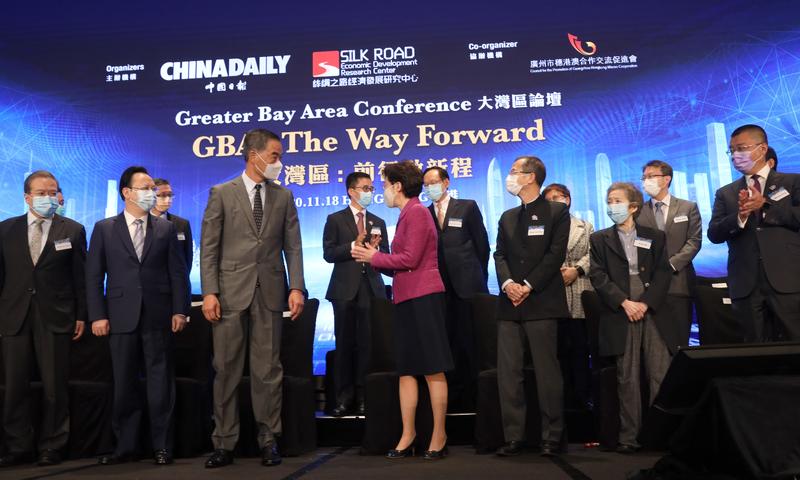 Organizers, speakers and panelists prepare to pose for a group photo during the Greater Bay Area Conference titled “GBA: The Way Forward” co-organized by China Daily and the Silk Road Economic Development Research Center at Marriott Hotel Hong Kong Ocean Park on Wednesday. (PARKER ZHENG / CHINA DAILY)
Organizers, speakers and panelists prepare to pose for a group photo during the Greater Bay Area Conference titled “GBA: The Way Forward” co-organized by China Daily and the Silk Road Economic Development Research Center at Marriott Hotel Hong Kong Ocean Park on Wednesday. (PARKER ZHENG / CHINA DAILY)
The epic fight against the coronavirus pandemic and the public’s growing healthcare needs in the face of perennial issues like an aging population demand high-level intergovernmental collaboration and coordination across the Guangdong-Hong Kong-Macao Greater Bay Area.
The call came from industry leaders and experts at a panel discussion themed “Reshaping Healthcare Sector amid COVID-19”, held as part of the Greater Bay Area Conference — GBA: The Way Forward co-organized by China Daily and the Silk Road Economic Development Research Center in Hong Kong on Wednesday.
They visualized the role that ever-changing technology can play in making the next big story unfold in the healthcare business.
“For most Asian and Chinese-speaking areas, the healthcare delivery system is typically and continues to be a high or ultra-high volume system, which means fairly high vulnerability to cross-infection in the face of an epidemic like COVID-19. This is the pre-existing condition for healthcare services in the Bay Area,” said Ko Wing-man, former secretary for food and health of the Hong Kong Special Administrative Region Government.
The implication, therefore, will be reflected in the continued adoption of various people flow control and infection control measures in different healthcare sectors, even when the pandemic is to cease, in whatever sense, he said.
“The healthcare system must adjust and define the set of baseline infection control measures and be prepared to maintain them for a much longer period of time,” Ko noted. “The continued adoption of stringent infection control and social distancing measures is certainly a strong driver for the development and adoption of innovation and technology-based, innovative models of care delivery. Such initiatives are indeed well underway.”
At the primary-care level, there’re already operators providing such services on the Chinese mainland or in the United Kingdom, either directly to client members or captured populations assigned by national or district healthcare authorities, he said.
“Whether it could gain popularity against a background of conveniently available primary-care providers locally in the community remains a question”.
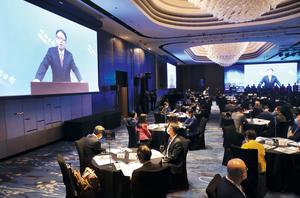 Zhou Shuchun, publisher and editor-in-chief of China Daily Group, delivers welcoming remarks at the Wednesday forum via a video link. (EDMOND TANG / CHINA DAILY)
Zhou Shuchun, publisher and editor-in-chief of China Daily Group, delivers welcoming remarks at the Wednesday forum via a video link. (EDMOND TANG / CHINA DAILY)
Advantages and challenges
Meanwhile, cross-boundary teleconsultation services, together with a structured delivery of medical supplies, are also underway. “The provision of teleconsultation and high levels of the so-called tiered medical care services would require further innovations, such as the establishment of teleconsultation centers in different Bay Area cities with video conferencing and diagnostics support,” Ko said.
However, at present, there’re still unresolved barriers or difficulties. In the context of medical, legal liability and professional patents, “it would be timely for governments of the Bay Area cities, including Hong Kong, to come together and establish the legal and professional framework to facilitate the development of I&T and an artificial intelligence-based new model of delivery of healthcare services”, Ko added.
Clifford Pang Lun-kee, president of Clifford Group and Clifford Hospital, said the development of healthcare services in the Bay Area reinforces the theme of closer collaboration across the region.
“Both the Guangdong municipal government and the HKSAR government need to formulate policies for the development of healthcare services in the Bay Area to bolster such vision,” he urged.
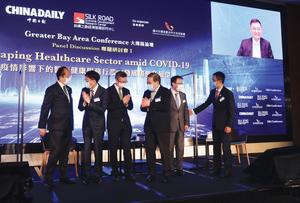 Panelists gather for a group photo. (EDMOND TANG / CHINA DAILY)
Panelists gather for a group photo. (EDMOND TANG / CHINA DAILY)
He believes that Hong Kong’s biggest competitive edges in the healthcare sector lie in its “international practices, advanced technology and high-end medical service experiences”.
For the Chinese mainland, whose medical industry has undergone more than two decades of development, it is well on its way to “tiered diagnosis and treatment, complete discipline construction, advanced technology, international service standards, as well as better healthcare and disease prevention services as required by the public”, Pang said.
In recent years, the nation has bankrolled sterling efforts in information and intelligence technologies that could essentially blaze a new trail in the healthcare sector and meet the growing healthcare needs of the public.
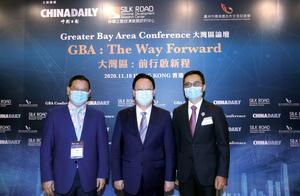 Tan Tieniu (center), deputy director of the Central People’s Government’s Liaison Office in Hong Kong SAR, and Zhou Li (right), publisher and editor-in-chief of China Daily Asia Pacific, line up for a group photo on Wednesday. (PARKER ZHENG / CHINA DAILY)
Tan Tieniu (center), deputy director of the Central People’s Government’s Liaison Office in Hong Kong SAR, and Zhou Li (right), publisher and editor-in-chief of China Daily Asia Pacific, line up for a group photo on Wednesday. (PARKER ZHENG / CHINA DAILY)
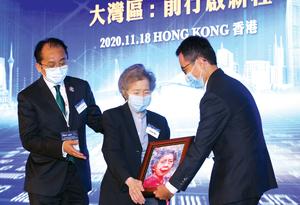 Annie Wu Suk-ching (Center), honorary chairman at Beijing Air Catering Co Ltd, receives a souvenir of her portrait at the venue. (EDMOND TANG / CHINA DAILY)
Annie Wu Suk-ching (Center), honorary chairman at Beijing Air Catering Co Ltd, receives a souvenir of her portrait at the venue. (EDMOND TANG / CHINA DAILY)
Technology key to development
Amid the COVID-19 pandemic, the disruptive technologies have waved magic wands at the forefront of the fight against the virus, with many internet platform-based medical enterprises offering teleconsultations through their WeChat official accounts, mobile applications and online platforms.
“These online services have reduced the massive influx of patients into the hospitals, minimized the risk of healthcare-associated infections in hospitals and saved excessive use of medical resources,” Pang noted.
Anthony Wu Ting-yuk, a member of the Standing Committee of the National Committee of the Chinese People’s Political Consultative Conference, highlighted the sheer power of technology. He said the very first thing that came to his mind at the panel discussion was technology. But he was also concerned that Hong Kong may lag behind in such a field.
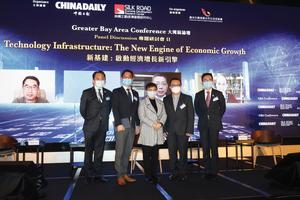 Speakers pose for a photo along with those who joined through video call. (EDMOND TANG / CHINA DAILY)
Speakers pose for a photo along with those who joined through video call. (EDMOND TANG / CHINA DAILY)
Unlike the mainland where telemedicine has played a significant role in serving patients and medicines are delivered all the way to doorsteps because of powerful logistic support, Hong Kong is still deemed a tiny, densely-populated city with no need for all sorts of things.
Wu firmly believes that Hong Kong experts should put their heads together to think about how they could take advantage of the technology of telemedicine and how logistics could better support telemedicine.
Wilson Tang, chief executive of BOC Group Life Assurance Co Ltd, told the conference that perennial issues such as aging population will be a big push for the healthcare and medical insurance businesses.
He recalled that in the 1980s, a larger part of Hong Kong’s working population had ever-increasing productivity. However, demographics show that what the city is facing today is a growing population who will retire soon.
 Clemente Contestabile, consul general of Italy in Hong Kong, reads this week’s GBA Focus, a weekly published by the China Daily Hong Kong Edition, at the forum. (EDMOND TANG / CHINA DAILY)
Clemente Contestabile, consul general of Italy in Hong Kong, reads this week’s GBA Focus, a weekly published by the China Daily Hong Kong Edition, at the forum. (EDMOND TANG / CHINA DAILY)
Based on that projection, in the next 20 years, people aged above 65 will account for 30 percent of Hong Kong’s population, and the working population will be much smaller than those nearing retirement because of the city’s low birth rate. The mainland is also facing the same problem, he said.
Among the thousands of people who made a beeline to ground zero of the coronavirus outbreak to join the battle against the virus in Wuhan, Hong Kong businessman Tse Chun-ming hit the road all the way to Wuhan from Hong Kong on Jan 22 — the day when he learned that the Hubei provincial capital would be shut down.
Tse, in his 60s and chairman of Hong Kong Asia Medical Holdings, founded the Wuhan Asia General Hospital in 2018 and the Wuhan Asia Heart Hospital in 1999.
 A guest takes a selfie during the conference. (EDMOND TANG / CHINA DAILY)
A guest takes a selfie during the conference. (EDMOND TANG / CHINA DAILY)
At the forum, his son Steven Tse Siu-kei, general manager of Wuhan Asia General Hospital, shared memories of the arduous battle against the pandemic, saying he’s grateful to the HKSAR government and numerous organizations for their support during the crisis.
“During the 78 days, we received more than 8,000 patients, including 821 COVID-19 patients who were taken to our hospital. Furthermore, we co-managed a module hospital which admitted more than 1,000 patients and with a zero death rate and zero infection among our medical staff,” he said in a pre-recorded video from Wuhan.
Contact the writers at sophia@chinadailyhk.com


